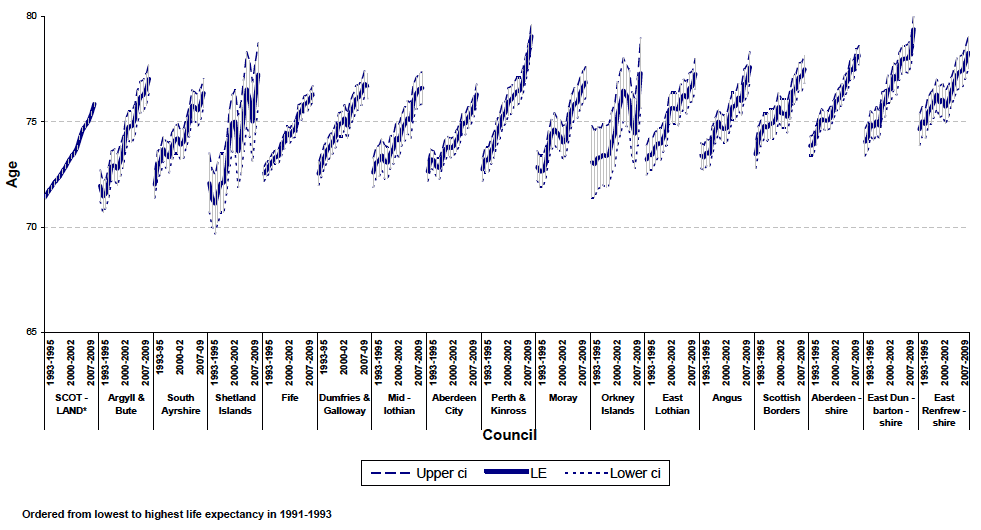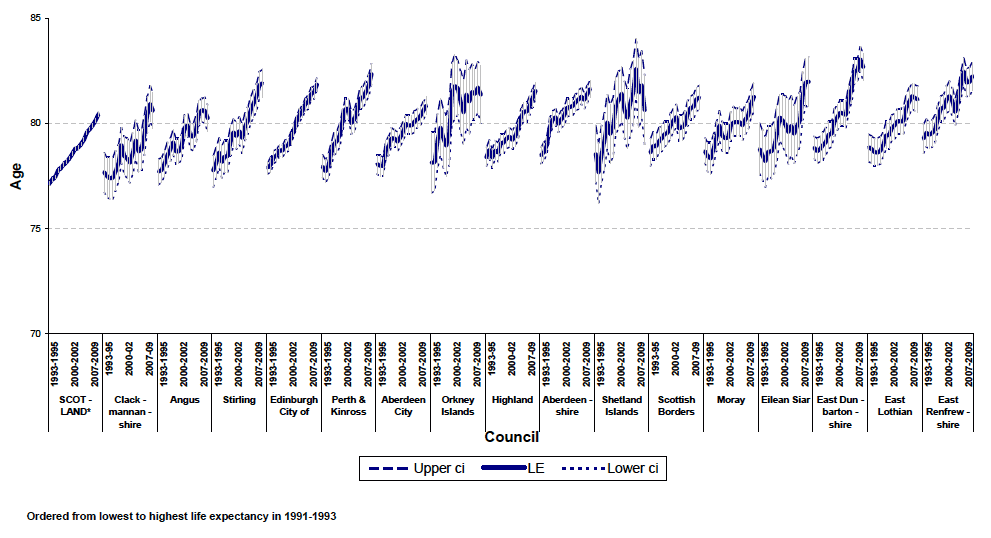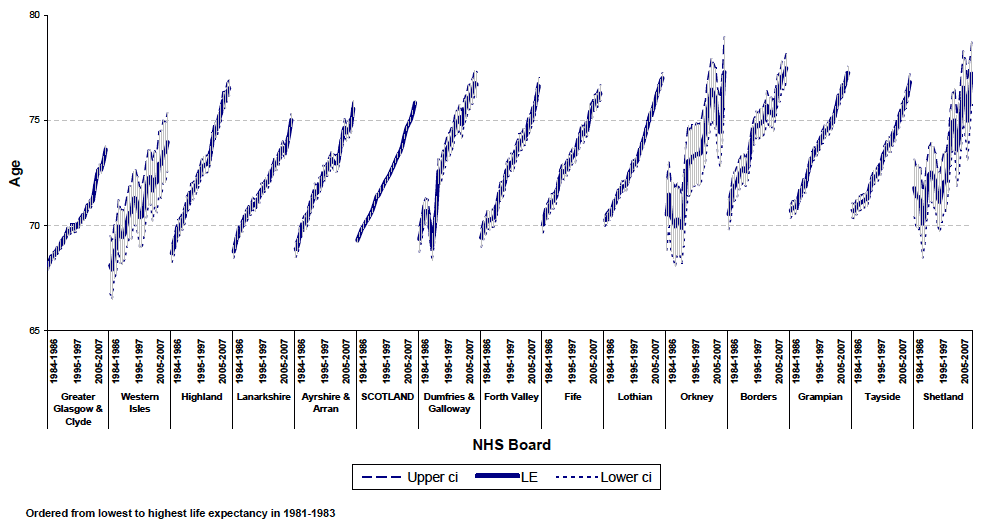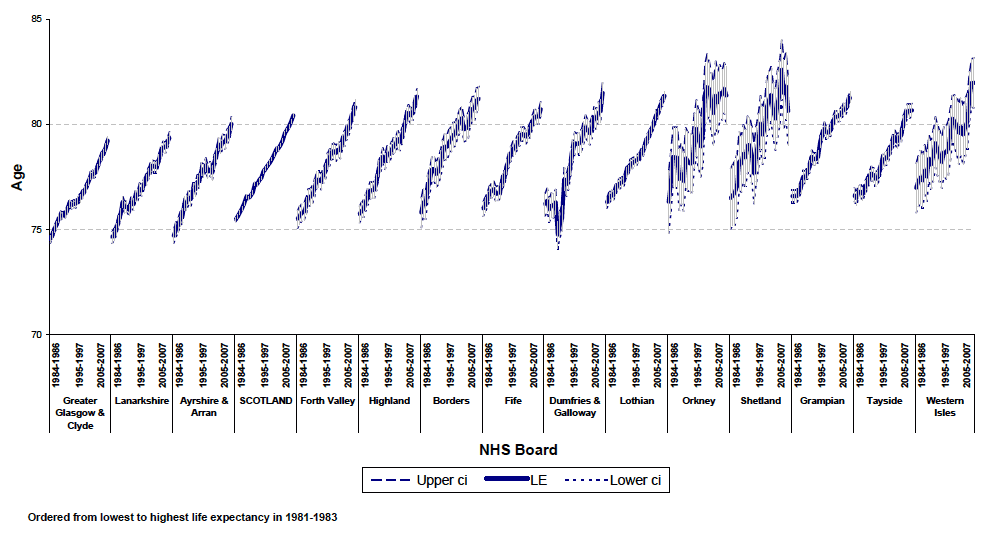
5.1.1 Figure 8 shows how male life expectancy within Council areas has changed since 1991-1993, with Council areas ordered from left to right by the lowest to highest life expectancy in 1991-1993.
5.1.2 Figure 9 shows how female life expectancy has also changed within Council areas since 1991-1993, with Council areas ordered from left to right by the lowest to highest life expectancy in 1991-1993.
5.1.3 Table 6 and Table 7 compare male and female life expectancies in 2008-2010 with those for 1998-2000 and 2003-2005 and give rankings for each area in the respective years. Comparisons made between these rankings may be subject to the margin of error within the life expectancy estimates.
5.1.4 Male life expectancy has risen in all Council areas since 1998-2000, with the biggest increase of 5.4 per cent (3.9 years) being in Argyll and Bute. Female life expectancy appears to have increased in most Council areas since 1998-2000. In Orkney Islands and Shetland Islands there were small decreases but these were not significant (Section 2.2). City of Edinburgh Council saw the biggest rise in female life expectancy, increasing by 3.6 per cent (2.9 years).
Figure 8 Life expectancy at birth in Scotland, 1991-1993 to 2008-2010, by Council area Males

Figure 8 Life expectancy at birth in Scotland, 1991-1993 to 2008-2010, by Council area Males (continued)

ci = confidence interval
* Scotland figure included twice for comparison purposes
Figure 9 Life expectancy at birth in Scotland, 1991-1993 to 2008-2010, by Council area Females

Figure 9 Life expectancy at birth in Scotland, 1991-1993 to 2008-2010, by Council area Females (continued)

ci = confidence interval
5.2.1 Figure 10 shows how male life expectancy has changed in NHS Board areas since 1981-1983 and is ordered from left to right by the lowest to highest life expectancy in 1981-1983. Figure 11 shows the same information for female life expectancy in NHS Board areas.
Figure 10 Life expectancy at birth in Scotland, 1981-1983 to 2008-2010, by NHS Board area, Males

Figure 11 Life expectancy at birth in Scotland, 1981-1983 to 2008-2010, by NHS Board area, Females

5.2.2 Table 6 and Table 7 compare male and female life expectancies in 2008-2010 with those for 1998-2000 and 2003-2005 and give rankings for each area in the respective years. Comparisons made between these rankings are subject to the margin of error within the life expectancy estimates.
5.2.3 Male life expectancy has risen in all NHS Board areas since 1998-2000, with Highland showing the biggest improvement, increasing by 5.0 per cent (3.7 years). Although male life expectancy in Greater Glasgow and Clyde remained at the same ranking of 14, it was second in terms of improvement, having increased by 4.8 per cent (3.3 years) since 1998-2000.
5.2.4 Female life expectancy increased in all areas except in Orkney and Shetland where there were no significant changes (Section 2.2). Lothian Health Board saw the biggest improvement, rising by 3.3 per cent (2.6 years).
5.3 Community Health Partnership areas
5.3.1 Table 8 and Table 9 compare male and female life expectancies in 2008-2010 with those for 1998-2000 and 2003-2005 and give rankings for each area in the respective years. Again, note that comparisons made between these rankings are subject to the margin of error within the life expectancy estimates.
5.3.2 All Community Health Partnerships (CHPs) have seen an increase in male life expectancy since 1998-2000, with Mid Highland CHP showing the biggest improvement, rising by 7.0 per cent (5.0 years). In terms of rankings, Mid Highland also saw the biggest improvement, rising from a rank of 29 in 1998-2000 to a rank of 13 in 2008-2010, with the biggest drop being in Dumfries and Galloway CHP, which was ranked 7 in 1998-2000 but ranked 17 in 2008-2010
5.3.3 All CHPs saw a rise in female life expectancy except for Orkney and Shetland where there were no significant changes. (Section 2.2). The biggest increase has been in Edinburgh CHP, which has risen by 3.6 per cent (2.9 years). Edinburgh CHP also saw the biggest improvement in its ranking, rising from a rank of 18 in 1998-2000 to a rank of 6 in 2008-2010.